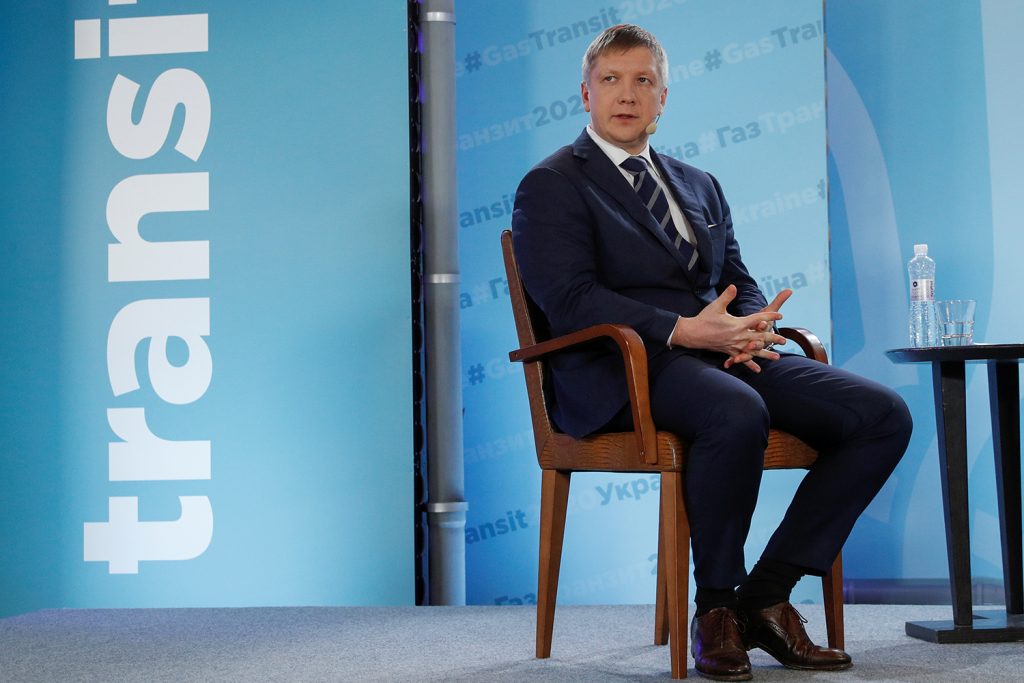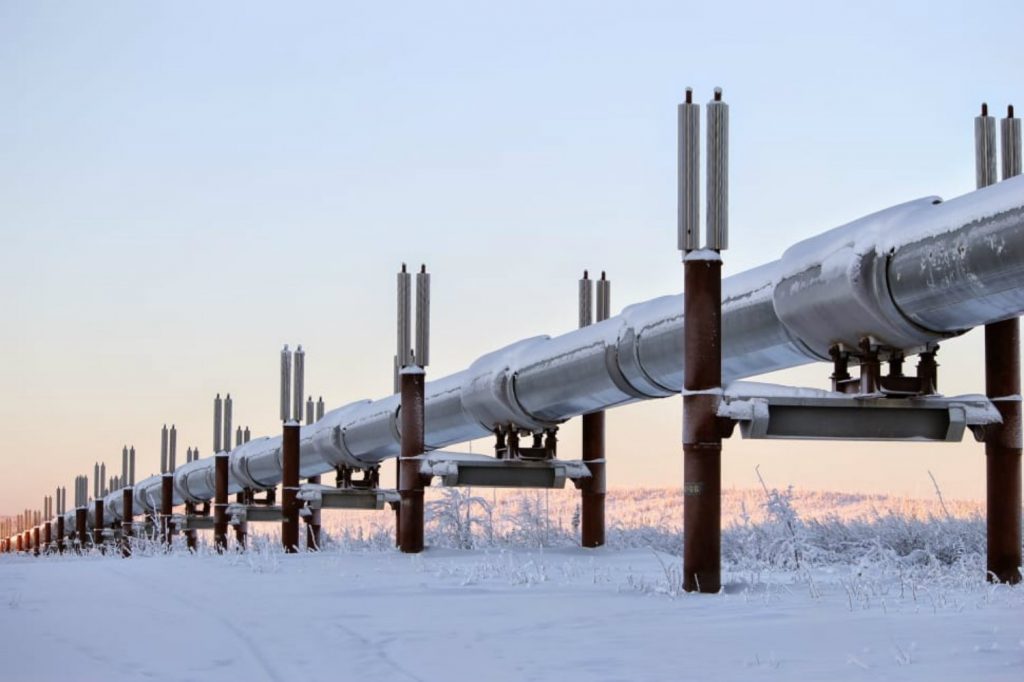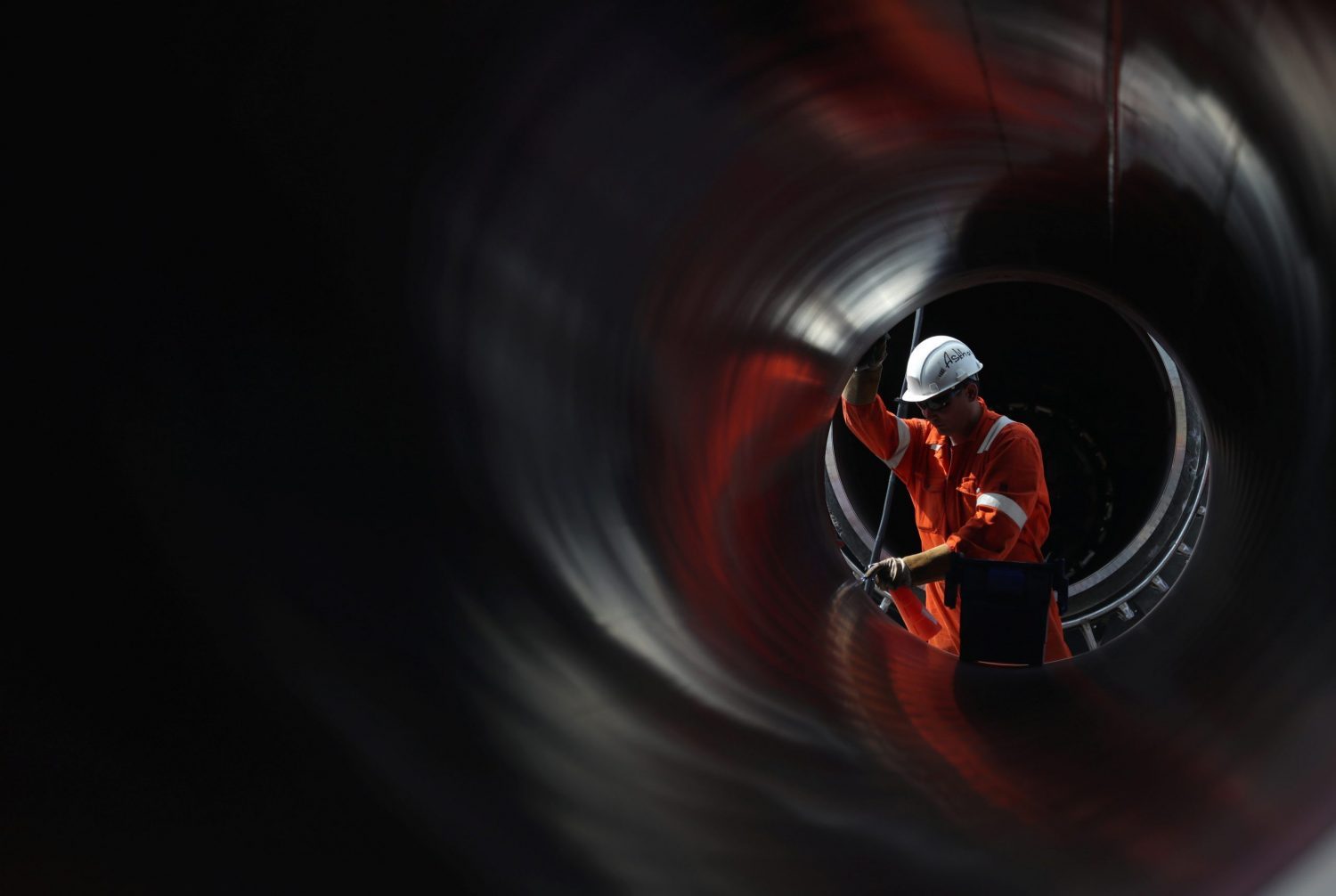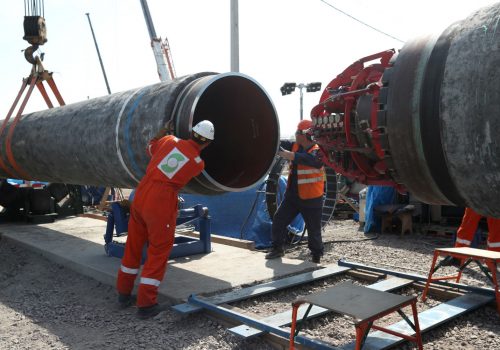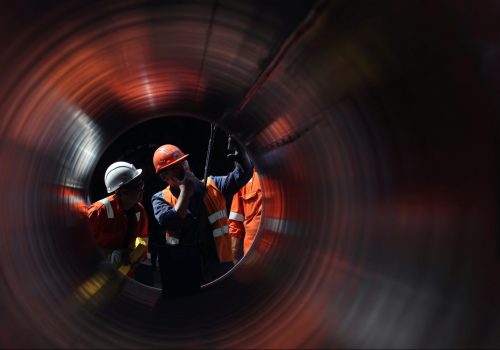After months of negotiations, Gazprom, Naftogaz, and Gas Transmission System Operator of Ukraine (GTSOU) signed a new agreement on the transit of natural gas to Europe, hours before the existing agreement was set to expire January 1, 2020. The new deal comes on the heels of US sanctions legislation against companies involved in completing Nord Stream 2, which was part of the 2020 National Defense Authorization Act (NDAA) signed into law on December 20. A cautious win for Ukraine, the agreement buys time for the country to reform its energy sector, which will be critical for Ukraine’s energy security, regardless of future contracts with Gazprom.
The new agreement: volumes, arbitration settlements, tariffs, and Ukraine’s gas imports
Unlike the previous ten-year deal between Gazprom and Naftogaz (2009-2019), the new deal is in force for five years and includes contracts between Gazprom and Naftogaz, and Gazprom and Ukraine’s newly established gas transmission system operator Gas Transmission System Operator of Ukraine (GTSOU). Ukraine is guaranteed a minimum annual transit volume of 65 billion cubic meters (bcm) in 2020 and 40 bcm annually the following four years. The contract could be extended for an additional ten years. In 2018, Gazprom transited 87 bcm of natural gas to Europe through Ukrainian pipelines. Gazprom’s plans for diverting roughly half of the previous volumes through Nord Stream 2 and TurkStream pipelines are reflected in the forthcoming dip in transit volumes. Already, Ukrainian transit to Southeast Europe is expected to be diverted from the Trans-Balkan pipeline to TurkStream. Bulgaria started receiving TurkStream gas in early January. Higher volumes are likely to be diverted from Ukraine’s transit system after the contract expires in 2024. Past transit through Ukraine fluctuated as high as 141 bcm in 1998, (before the Nord Stream pipeline from Russia to Germany, and the Blue Stream pipeline connecting Russia and Turkey came online,) and as low as 62 bcm in 2014, when Russia invaded and annexed a part of Ukraine’s territory.
Arbitration settlements between the two countries were a key part of the deal.In exchange for the transit volume commitments, Ukraine is dropping multi-billion dollar arbitration claims against Gazprom and has agreed to release seized Gazprom assets in Europe. Gazprom agreed, however, to pay $2.9 billion by the end of 2019, which was previously awarded by a Swedish Court in 2018 for compensation and includes interest. On December 27, Naftogaz received the payment. To tie up any additional legal “loose ends,” both parties agreed to drop reciprocal court claims where the final decisions have not been reached, and to forego any future claims relevant to the 2009 contract. The deal does not impact claims against Russia regarding the assets it seized in Crimea.
Adoption of the European Union’s Third Energy Package legislation is enabling Ukraine to charge market-based rates for its transit services and to include a “pump or pay” clause, which commits Gazprom to pay the transit fee if the agreed-upon minimum volumes are not pumped through Ukraine’s system. According to Ukrainian Energy Minister Oleksiy Orzhel, the transit tariff will be based on European methodology for tariff calculation, which establishes a transparent, competitive, and market-driven tariff framework. Before the final contracts were signed, Orzhel estimated that Ukraine will generate $15 billion for transmitting 225 bcm of Russian gas to the EU. This is an average of $3 billion per year for the next five years, roughly what Naftogaz was previously receiving for almost twice the transit amount. But, on December 30, Ukrainian President Volodymyr Zelenskyy announced a more conservative figure, posting on social media that Ukraine will receive at least $7 billion from the fees. Transit above the minimum contractual volumes will be charged a higher tariff. Until Nord Stream 2 comes online, Gazprom will transit above minimum volumes, in all probability. The total fees would depend on the actual volume Gazprom will pump through Ukraine, the amount will be driven by European demand and pricing. The reliance on natural gas imports will increase in Europe as homegrown production declines and as EU member states retire coal and nuclear power plants.
In addition to the transit volumes, the negotiating parties discussed direct deliveries of natural gas to Ukraine from Russia. No agreement was reached in this area. Since 2015, Ukraine has been purchasing Russian gas indirectly, through reverse flows from neighboring countries as a way of mitigating Russian leverage. Gazprom offered Ukraine a 20-25 percent discount for gas, compared to what Ukraine is paying now for Russian gas delivered through Europe. The discount mentioned by Gazprom could be partially negated because Ukraine receives transit fees for the gas it pumps to Europe and then purchases through reverse flows. By receiving the gas directly, it could lose some of those fees. Ukraine should carefully evaluate the risks of purchasing Russian gas directly again and ensure that alternative methods through reverse flows from Europe are available as a backup in case Gazprom chooses to use energy supply as leverage.
What was at stake?
Reliable transit of natural gas through Ukraine is essential for European energy security. Europe receives roughly 40 percent of its Russian natural gas imports through Ukraine and past gas disputes and shut offs between Russia and Ukraine have had significant impacts on Europe’s energy supply. But in 2019 European markets were substantially better prepared for a gas cut off if the transit agreement was not reached. Europe improved its supply resiliency in several ways. The European natural gas storage facilities were filled near capacity. Most importantly, the EU strengthened its regulatory framework and made substantial investments to diversify natural gas supplies through building natural gas interconnectors, liquefied natural gas (LNG) infrastructure, storage facilities, and integrating reverse flows technologies. Additionally, Ukraine discussed cooperation with nearby countries, including Moldova and Romania, on alternative transit scenarios.
Despite these risks, the uncertainty of future transit through Ukraine was a bigger concern for European’s security of supply in the long term. The absence of a deal would have likely led to a rise in natural gas prices in Europe. Uncharacteristically low seasonal natural gas prices, however, brought on by the saturated market, would have softened the price hike. And the lower than usual consumption in Europe, due to the mild winter, would lessen anticipated supply demands.
Who won?
Transit volume
The deal is a better than expected compromise for Ukraine, considering the circumstances. In 2018, Gazprom’s Alexei Miller discussed transit levels as low as 10 and 15 billion cubic meters per year, at the time accounting for a timely completion for Nord Stream 2. The agreed-upon natural gas volumes are relatively close to the 60 bcm annual transit volume Ukraine proposed in October.
The length of the agreement
While Ukraine did not get the ten-year agreement it wished for, the five-year deal provides some short-term certainty in the anticipated transit income. It is also a better alternative than the one-year contract proposed by Russia. Considering that natural gas markets are becoming more interconnected and competitive, five years is a reasonable timeframe.
Arbitration settlement
While giving up billions of dollars in legal claims was a considerable concession for a $130 billion gross domestic product (GDP) nation, the payment of the $2.9 billion is a significant gain for Ukraine. It is very unlikely that Gazprom would have honored awarded payments without receiving something in return, since Gazprom does not have a track record of abiding by the international rules-based system. As an old Russian proverb says: “A tomtit in your hand is better than a crane in the sky.”
Did the US sanctions seal the deal?
Recent US sanctions targeting deep sea pipe-laying vessels, specifically those involved in the Nord Stream construction, may have had an impact on negotiations. Nord Stream 2, is set to double Russia’s direct natural gas transit capacity to Germany. The contentious 55 bcm pipeline was originally planned to go online by the end of 2019, which would have given Gazprom tremendous leverage in negotiating the next transit deal or opting to go without one at all, rerouting most of the transit volume through Nord Stream 2 and TurkStream.
The Danish approval process delayed construction by several months in 2019, but the most significant delay could be the result of US sanctions targeting deep sea pipe-laying vessels involved in Nord Stream 2 and TurkStream construction. The sanctions were a part of the 2020 NDAA bill, signed into law on December 20. Allseas, a Swiss contractor laying the Nord Stream 2 pipes, suspended all Nord Stream 2 related operations, making the following statement: “Allseas will proceed, consistent with the legislation’s wind down provision and expect guidance comprising of the necessary regulatory, technical, and good-faith efforts.” Even though the wind-down period is thirty days per the sanctions legislation, companies involved in laying the pipes should make “good faith” efforts to wind down operations immediately.
While the sanctions are unlikely to stop the project altogether, they have delayed the project at a critical moment in negotiations. Russia would need to secure alternative contractors and vessels to finish the work on Nord Stream 2. One of the options for Russia is to utilize Gazprom’s vessel Akademik Cherskiy to finish the last 7-8 percent of the project. The vessel is currently docked in the Far East at the Russian Pacific port of Nakhodka and will require maintenance to be operational. It would also take several months for the vessel to arrive on site. Delays could be significant, but the exact completion timeline is unclear.
Some concern remains that Gazprom will comply with the signed agreement, since the company has breached contracts in the past. As Ambassador Morningstar and Ambassador Fried proposed, contingency sanctions could be enacted under existing authorities if Gazprom acts in bad faith and breaches the current agreement.
The next five years will be crucial for the future of Ukraine’s energy security
While the new contract is positive news for Ukraine and European countries reliant on transit, the deal also gives Ukraine vital time to do its “homework” and figure out a resilient long-term energy strategy, especially in the natural gas sector.
The recently-merged Ministry of Energy and Environmental Protection of Ukraine has an ambitious reform agenda, but the on-the-ground implementation will be the litmus test to its success. The Naftogaz unbundling process is officially completed and GTSOU transported gas as an independent operator on January 1. Nevertheless, the National Energy and Utilities Regulatory Commission (NEURC) will have to keep a close watch to make sure that GTSOU stays in compliance with the EU laws.
The state of Ukraine’s transmission network was a contentious topic during the transit talks. While the state of the network is not as poor as Gazprom proclaimed, opportunities for maintenance and security improvements most likely exist. Regardless, the network is due for a comprehensive transparent assessment (with a third impartial party certification). The next five years provide the necessary income to perform the survey, which could also be funded by external grants. Strategic modernization of the transmission system could also reduce technical losses during transmission, such efficiencies would bring financial and environmental benefits.
Ukraine should continue working towards being self-sufficient in natural gas though ramped up homegrown development of natural gas fields. Although the country made significant progress in opening new blocks for natural gas development and implemented online auctions, the transparency in license awards must be improved in order to attract foreign investors.
Correspondingly, support from the transatlantic community must continue, including cooperation with international financing organizations such as European Investment Bank and US Development Finance Corporation (DFC). All of those steps will be necessary for a strong Ukrainian energy sector with or without the Russian natural gas transit after 2024. The developments in the next five years will either set Ukraine on the path to energy independence and security or deepen the country’s reliance on Russian energy supplies and transit fees.
Olga Khakova is associate director for European energy security at the Atlantic Council’s Global Energy Center.
Further reading:
Image: Naftogaz CEO Andriy Kobolev attends a news briefing in Kiev, Ukraine December 31, 2019. REUTERS/Valentyn Ogirenko
